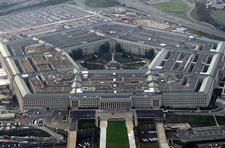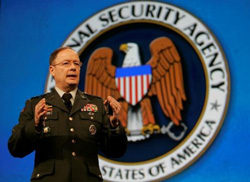redo Jump to...
print Print...
 (by Ellen Nakashima, Washington Post) – The U.S. Pentagon has approved a major expansion of its cybersecurity force over the next several years, increasing its size more than fivefold to bolster the nation’s ability to defend critical computer systems and conduct offensive computer operations against foreign adversaries, according to U.S. officials.
(by Ellen Nakashima, Washington Post) – The U.S. Pentagon has approved a major expansion of its cybersecurity force over the next several years, increasing its size more than fivefold to bolster the nation’s ability to defend critical computer systems and conduct offensive computer operations against foreign adversaries, according to U.S. officials.
The move, requested by the head of the Defense Department’s Cyber Command, is part of an effort to turn an organization that has focused largely on defensive measures into the equivalent of an Internet-era fighting force. The command, made up of about 900 personnel, will expand to include 4,900 troops and civilians.
Details of the plan have not been finalized, but the decision to expand the Cyber Command was made by senior Pentagon officials late last year in recognition of a growing threat in cyberspace, said officials, who spoke on the condition of anonymity because the expansion has not been formally announced. The gravity of that threat, they said, has been highlighted by a string of sabotage attacks, including one in which a virus was used to wipe data a from more than 30,000 computers at a Saudi Arabian state oil company last summer.
The plan calls for the creation of three types of forces under the Cyber Command: “national mission forces” to protect computer systems that undergird electrical grids, power plants and other infrastructure deemed critical to national and economic security; “combat mission forces” to help commanders abroad plan and execute attacks or other offensive operations; and “cyber protection forces” to fortify the Defense Department’s networks.
Although the command was established three years ago for some of these purposes, it has largely been consumed by the need to develop policy and legal frameworks and ensure that the military networks are defended. Current and former defense officials said the plan will allow the command to better fulfill its mission.
“Given the malicious actors that are out there and the development of the technology, in my mind, there’s little doubt that some adversary is going to attempt a significant cyberattack on the United States at some point,” said William J. Lynn III, a former deputy defense secretary who helped fashion the Pentagon’s cybersecurity strategy. “The only question is whether we’re going to take the necessary steps like this one to deflect the impact of the attack in advance or . . . read about the steps we should have taken in some post-attack commission report.”
Although generally agreed to by the military’s service chiefs, the plan has raised concerns about how the Army, Navy, Marines and Air Force will find so many qualified cybersecurity personnel and train them. It also raises deeper issues – which are likely to intensify as the Cyber Command grows over the years – about how closely the command should be aligned with the National Security Agency [NSA], the giant electronic-spying agency that provides much of its intelligence support.
The head of the Cyber Command, Gen. Keith B. Alexander, is also the director of the NSA, which employs some of the nation’s most advanced cyber-operations specialists. …
In an interview, a senior defense official said that the “national mission” teams would focus their efforts overseas and that any actions they took would be directed outside U.S. networks – unless the teams were asked to provide assistance to another agency with domestic authority, such as the FBI.
“There’s no intent to have the military crawl inside industry or private networks and provide that type of security,” the official said.
He stressed that the military would act only in cases in which there was a threat of an attack that could “really hurt,” adding: “We’re not talking about doing something to make sure that Mrs. Smith’s bank account didn’t get hijacked by somebody.” …
Some military and defense officials question whether the Cyber Command can reach its full potential as a military command as long as it is so dependent on the NSA and is led by the NSA’s director. The close relationship between the two has had its advantages, officials say: The agency can peer into foreign networks and provide the command with intelligence, including in cases in which an adversary is suspected of planning a computer attack or developing a potent virus.
“That gives you an advantage of being able to plan for and be prepared to react,” the defense official said.
But the NSA is so intertwined with the Cyber Command – the two operations centers are located side by side, and, until recently, some Cyber Command personnel had nsa.gov e-mail addresses – that some current and former officials wonder whether the military command can create an independent, strategic doctrine. The concern is that the intelligence agency’s priorities will dominate, with an emphasis on the development of tools that are useful for surveillance but not necessarily for disrupting adversaries. …
But, in fact, said one former intelligence official, the NSA uses military personnel to do much of its work and pays for a good portion of the services’ cyber operators. “That’s been the plan all along,” the former official said. “Take the talent resident in NSA, turn it into [cyber] attack talent.”
With the decision to expand the Cyber Command, Alexander, who has been asked to stay on until summer 2014, is seeing some of his vision fulfilled. He has sought independent budget authority for the Cyber Command to hire and control forces, similar to the way Special Operations Command can. He has not won that authority, though officials agreed to give him the additional forces. He also has the support of senior Pentagon officials to elevate the Cyber Command to full command status, out from under the aegis of Strategic Command. But that move, which requires consulting with Congress, is not happening just yet, officials say.
First published at WashingtonPost.com on Jan.27th. Excerpted here for educational purposes only. May not be reproduced on other websites without permission from The Washington Post.
Questions
1. The first paragraph of a news article should answer the questions who, what, where and when. List the who, what, where and when of this news item. (NOTE: The remainder of a news article provides details on the why and/or how.)
2. a) What is Cyber Command? Be specific. (see “Background” below the questions)
b) By how much is Cyber Command’s personnel about to increase?
c) How will this expansion change the work of Cyber Command?
3. Why have senior Pentagon officials decided to expand Cyber Command?
4. How will Cyber Command be expanded to meet the growing threats?
5. a) What did former deputy defense secretary William Lynn say about cyberattack threats against the U.S.?
b) Do you agree with Mr. Lynn’s viewpoint that we should be proactive against cyberattacks?
6. a) What is the main concern about hiring new personnel for Cyber Command?
b) Do you think this is a legitimate concern? Explain your answer.
7. a) What assurance has a senior defense official given that Americans do not have to worry about government invasion of their privacy?
b) Are you concerned that invasion of privacy could occur? Explain your answer.
Background
U.S. Cyber Command:
- On June 23, 2009, the Secretary of Defense directed the Commander of U.S. Strategic Command to establish The United States Cyber Command (USCYBERCOM). Initial Operational Capability (IOC) was achieved on May 21, 2010 and Full Operating Capability (FOC) was achieved Oct. 31, 2010. The command is located at Fort Meade, Md.
- Formal Command Name: U.S. Cyber Command (USCYBERCOM or CYBERCOM).
- Commander: General Keith B. Alexander
- Mission: USCYBERCOM is responsible for planning, coordinating, integrating, synchronizing, and directing activities to operate and defend the Department of Defense [DoD] information networks and when directed, conducts full-spectrum military cyberspace operations (in accordance with all applicable laws and regulations) in order to ensure U.S. and allied freedom of action in cyberspace, while denying the same to our adversaries.
- Focus: The command is charged with pulling together existing cyberspace resources, creating synergy that did not previously exist and synchronizing war-fighting effects to defend the information security environment.
The Command centralizes direction of cyberspace operations, strengthens DoD cyberspace capabilities, and integrates and bolsters DoD’s cyber expertise. USCYBERCOM improves DoD’s capabilities to ensure resilient, reliable information and communication networks, counter cyberspace threats, and assure access to cyberspace. The command works closely with interagency and international partners in executing the cyber mission. (stratcom.mil/factsheets/Cyber_Command)
U.S. Strategic Command:
- Oversees Cyber Command and the U.S. nuclear weapons arsenal
- USSTRATCOM integrates and coordinates the necessary command and control capability to provide support with the most accurate and timely information for the President, the Secretary of Defense, other National Leadership and regional combatant commanders. (stratcom.mil/about)
The National Security Agency (NSA):
- The National Security Agency (NSA) is a cryptologic intelligence agency of the U.S. Department of Defense responsible for the collection and analysis of foreign communications and foreign signals intelligence, as well as protecting U.S. government communications and information systems, which involves information security and cryptanalysis/cryptography.
- The NSA is a key component of the U.S. Intelligence Community, which is headed by the Director of National Intelligence.
- The Central Security Service is a co-located agency created to coordinate intelligence activities and co-operation between NSA and other U.S. military cryptanalysis agencies.
- The Director of the National Security Agency serves as the Commander of the United States Cyber Command and Chief of the Central Security Service. (from wikipedia. Visit the website at nsa.gov)
The United States Special Operations Command (USSOCOM):
- USSOCOM is the Unified Combatant Command charged with overseeing the various Special Operations Commands (SOC or SOCOM) of the Army, Air Force, Navy and Marine Corps of the United States Armed Forces.
- The command is part of the Department of Defense.
- Since its activation on 16 April 1987, U.S. Special Operations Command has participated in many operations, from the 1989 invasion of Panama to the ongoing War On Terror.
- USSOCOM conducts several covert and clandestine missions, such as unconventional warfare, foreign internal defense, special reconnaissance, psychological warfare, civil affairs, direct action, counter-terrorism and War on Drugs operations.
- Each branch has a Special Operations Command that is unique and capable of running its own operations, but when the different Special Operations Forces need to work together for an operation, USSOCOM becomes the joint component command of the operation, instead of a SOC of a specific branch. (from wikipedia. Visit the website at socom.mil)
Daily “Answers” emails are provided for Daily News Articles, Tuesday’s World Events and Friday’s News Quiz.




